Lemurs of Madagascar
- The Aye Aye lemur, one of the most rare lemurs in the world -
| |
|
|
|
Aye Aye lemur or Daubentonia madagascariensis ( revised on February 2012 )
Is a lemur in spite of its rodent teeth, its big owl eyes, its very large hypersensitive bat ears and its thick tail. It belongs to a monotypic family : the Daubentoniidae family. So Aye Aye is distinct from all other primates. Because of this strange morphology Aye Aye is one of the most unusual mammals on Earth.
Aye Aye is the largest nocturnal lemur. It has a dark grey-brown coat. Nowadays there is just few individuals of this species in the world. Aye Aye lemur lives in the primary evergreen rainforests and in the worn out deciduous dry forests of Madagascar. Sometimes too you can found them in degraded and cultivated areas like lychee and coconut plantations.
|
|
|
|
|
|
|
|
|
|
|
|
The most indicated spot for its observation is NORTHERN MANANARA ( or MANGABE ISLAND ). And if you are lucky, in humid forest of Montagne d'Ambre, or in deciduous forest of Ankarana, or in Bemaraha Tsingy National Park, or in Tsiombikibo forest near Mitsinjo-Soalala. But Aye Aye is one of the most difficult lemurs to see in the wild.
Aye Aye lemur is strictly nocturnal and it is a solitary animal. It builds its nest ( made of dead leaves and branches ) in a crotch of the large trees in dense tangles ( between 7 and 20m from the ground ). Large trees contain up to six nests wich are occupied for several days. They scent-mark regularly through urination.
|
Aye Aye lemur ( Madagascar )
Gives birth to only one baby per range with a 160 - 170 gestation days. The mother breeds its little baby with its breasts situated between its posterior legs. Infant remains with mother for long period, allowing them to learn the complex foraging techniques needed for survival.
If you see two Aye Aye lemurs in a nest, it will be the mother & its baby. Male Aye Aye has large home ranges : 125 to 215ha and it is capable of travelling 2 - 4km per night. Female home ranges is smaller : 30 to 50ha.
Except for the Aye aye Lemur and the Lac Alaotra Gentle Lemur, lemurs are seasonal breeders with very short mating and birth seasons influenced by the highly seasonal availability of resources in their environment. Males and females of Aye Aye lemur may mate with several partners.
Madagascar : the Tsingy, Nosy Be area, Baobab
Here is the Black and white ruffed lemur
Aye Aye lemur ( Madagascar )
Has a short and piercing cry when it is afraid. Vocalisations are short « cree-cree-cree » lasting just 2 to 3 seconds. And their activity begins up to 30mn before sunset.
It has 18 teeth including 14 molar mashers, 2 upper incisors and 2 lower incisors ; all the 4 incisors are very long and cutting. They help Aye Aye to shear the barks, to pierce the coconuts.
Diet consists mainly of nectar from Traveller's Tree Ravenala madagascariensis, interior of Ramy nuts Canarium madagascariensis, fungi and insect grubs, lychees, mango and coconut plantations. Head/body length of Aye Aye is from 300 to 370mm and tail length is from 440 to 530mm. Its weight is about 2.5kg.
Aye Aye lemur ( Madagascar )
Has 5 very long skeletal fingers which finished by claws, the 3rd thinger can rotates in all directions ( 360 ° ). It uses this finger to excavate cavities and to catch larvaes from holes, insects or the pulp of fruits ( especially coconuts, cane sugar, mangos and lychees ). It uses its large ears to locating insect larvae in dead wood.
Up to 80 % of night spent travelling and foraging in upper canopy. Also descends to ground and sometimes covers large distances. It is virtually certain that Aye Aye species ( unique in the world ) was driven to extinction by human action.
|
|
|
|
|
|
|
|
|
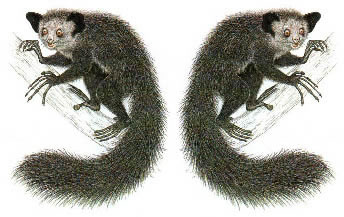
Illustration by Stephen D. Nash
| |
|
|
|
Where to see AYE AYE LEMURS ?
Madagascar, a nature sanctuary, IS FAMOUS for its lemurs, for its Baobabs, and for its fauna and flora where most of them are endemic, you can not find them anywhere else.
I propose you THE BEST itinerary in just 8-days-tour ( Antananarivo airport - Antananarivo airport ) to see maximum lemurs species including THE VERY RARE Aye Aye nocturnal lemur which you will find in the nature in this Tour, it's an exceptional experience in life, an animal that you will find and take in photos only here in Madagascar.
In this Tour you will see and appreciate two different landscapes : the western dry forest and the eastern evergreen rainforest which is completely different from the first one.
With four visits :
- Kirindy dry forest (nocturnal and diurnal walks)
- The famous Baobabs Avenue at sunset and other baobabs
- Andasibe Natural Park (nocturnal and diurnal walks) and
- Palmarium lemurs Park.
The Tour can be customized for your number of people. Accomodation in extra cost.
|
|
D1: Tana - Antsirabe
Welcome at Tana airport, change then direct drive to Antsirabe
D2: Antsirabe - Kirindy
Early morning departure. Kirindy forest wildlife nocturnal walk
D3: Kirindy - Morondava
Kirindy forest a.m.
The sacred baobab, the twins-baobabs and the famous ‘Baobabs Avenue’ at sunset
D4: Morondava - Antsirabe
D5: Antsirabe - Tana - Andasibe
Andasibe wildlife nocturnal walk
D6: Andasibe - Pangalanes
Andasibe Park NP a.m. to see the biggest lemur in the world. Drive and boat to the Pangalanes. Nocturnal walk to see the rare Aye Aye lemur
D7: Pangalanes - Andasibe
Palmarium lemurs Park a.m. Boat and drive back p.m.
D8: Andasibe - Tana
Drive back to Tana with a possible direct transfer to Tana airport
|
Price : 1450 Euros for 2 Persons
TAKE WITH YOU :
Anti-mosquito spray and cream, pocket torch and spare batteries, head torch if possible, light clothes as well as clothes to keep you warm ( for the nights ), cameras, small good padlocks for your luggage, your personal medicines ( current antibiotics, antidiarrhoea, antiseptics, Betadine, compresses and cotton, purifying tablets, ointment for sprains, lip salve and other personal medicines, protect yourself against malaria, e.g. follow a treatment ) sun cream, sun glasses, walking shoes or closed sports shoes, binoculars, k-way or raincoat, hat or cap, AND cash money = euros.
|
|
|
|
|
|
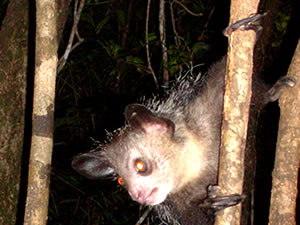 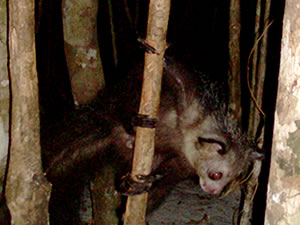
Aye Aye, Madagascar, Ravo.Madagascar 2014 ©
Everyone who has visited Madagascar, talks about it
with nostalgia & dreams to come back one day
| |
|
|
|
Another place where you can see Aye Aye
Masoala's pristine evergreen rainforest
( a National Park in Madagascar ) :
Created in 1997, Masoala National Park is the largest protected forest in Madagascar. Conservationists and scientists praise the park as the last stronghold and refuge for many species facing increasing threats from slash-and-burn farming and logging practices. The park contains significant portions of lowland and coastal rainforest from sea level to 1200 m, covering about 230 000 ha. It is located in the northeast region of Madagascar, bordering the Bay of Antongil and the Indian Ocean.
There are hiking trails that skirt the entire peninsula, stretching from Maroantsetra to Mahavelona and all the way down to Cap Masoala via Tampolo Marine Park. From here, it continues along the coast past Ifaho Marine Park, then upwards towards Cap East and further along to the town of Antalaha. The main trails for visitors are at Tampolo / Ambodiforaha, Cap East and a multi-day hike is possible across the peninsula from Maroantsetra to Cap East ( 5-8 days ). You need porters and cook for this big trekking. Porters, cook and guide are available in Maroantsetra.
The waters around the peninsula is rich in marine life and the bay is protected from strong winds. The pristine beaches are perfect for swimming and snorkelling ( take your equipment with you )
|
|
|
|
|
|
|
|
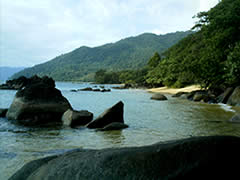
Forest-type where you can seeAye Aye lemurs
Ravo.Madagascar pictures ©
| |
|
|
|
Masoala National Park, in the North East part of Madagascar :
( Where you can see Aye Aye lemur ) is a spectacular sanctuary of life : 230 000 hectares of primary forest. Masoala National Park : a preserving natural heritage and nature's aquariums with its three marine protected areas. The Park has a large endemic and unique species of flora and fauna such as lemurs, geckos, frogs and birds.
Whether you are a naturalist in search of pristine rainforest, a hiker thirsty for adventure, or a vacationer in search of paradise, a jewel of emerald forest surrounded by an azure ocean awaits you. Come and enjoy the beauty of Masoala. Various trails provide unforgettable trekking ( the adventurous can traverse the peninsula from Maroantsetra to Cap-Est ; or from Maroantsetra to Antalaha ; or to explore the East coast : the region of Ambanizana, Ambodiforaha, Lohatrozona, Tampolo and Antalaviana ).
|
|
|
|
|
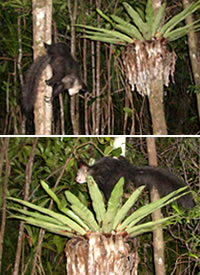
1st pictures : Aye Aye in its natural habitat - Ravo 2014 ©
2nd picture : Ambanizana River (Masoala National Park area)
Yannick Blanchard 2006 picture ©
Clients' Testimonies after their trips in Madagascar :
| |
|
|
|
Erik Segers ( Belgium ) has written in « LinkedIn » :
If you want to discover Madagascar, Ravo is your man to organise your trip from A to Z. Thanks to his deep knowledge and boundless enthusiasm we had a truly first class visit of this wonderful island. Without a doubt, I do recommend, wholeheartedly.
Another person says, always in « LinkedIn » :
Ravo is an all-round tour guide and entirely devoted to his clients. Ravo will take care of everything, methodically and professionally. It’s with immense pleasure that I will ask him once more to guide me through his magnificent island, Madagascar ( Emmanuel Leborgne - Canada )

|
|
|
|
|
  
Madagascar, a wonderland for nature lovers
RATSIMBAZAFY Ravo Nomenjanahary
Copyright © 2000 Christian-thought
e-mail : r_ravo@hotmail.com
Tel. ++ 261 32 41 063 65

The Christian
Counter


Webspace Provider
|
|
|
|